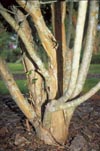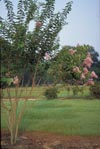Home >
Lagerstroemia x 'Muskogee',
Muskogee Crapemyrtle
'Muskogee' grows best in full sun with rich, moist soil but will tolerate less hospitable positions in the landscape just as well, once it becomes established. However, plants left on their own in highway medians appear to be less vigorous unless ample mulch is applied and maintained out to the drip line. The best plants are often located in irrigated landscapes. Plants defoliate in severe drought but new foliage and flowers typically emerge when summer rain returns. This cultivar has an unusually long blooming period lasting up to 120 days.
It grows well in limited soil spaces in urban areas such as along boulevards, in parking lots, and in small pavement cutouts if provided with some irrigation until well established. They tolerate clay and alkaline soil well. Note the light gray-brown bark on this cultivar. This plant is considered mostly allergy free and causes little or no allergy problems in most people. This is one the few cultivars that grow well in south Florida.
Many crapemyrtles are magnets for a host-specific aphid that only infests crapemyrtle, not other plants. The damage this causes is not lethal to crapemyrtle. Many beneficial insects which feed on pests that damage other landscape plants use this aphid for food. In this way, the crapemyrtle aphid serves as prey for beneficial insects. Therefore, planting crapemyrtle that attract aphids can enhance biological control of insect pests on other plants in the landscape.





